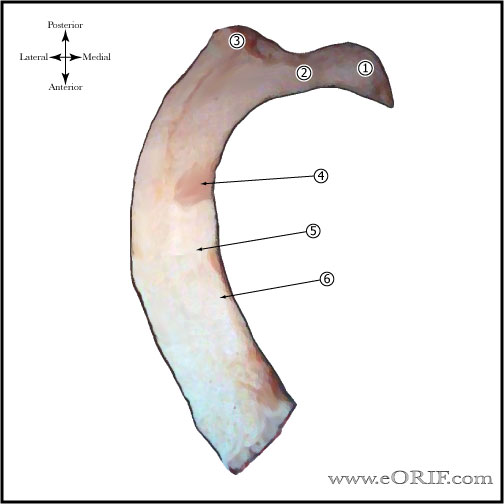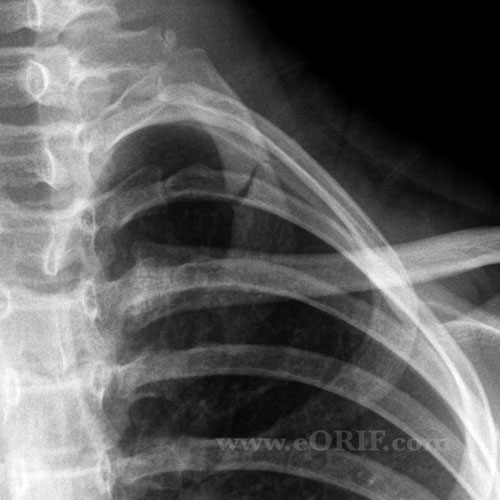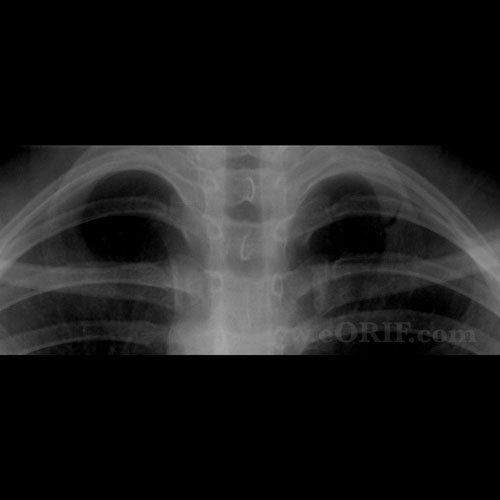|



|
synonyms:
Rib Stress Fracture ICD-10
Rib Stress Fracture ICD-9
- 807.01 (fracture of rib, closed, one rib)
- 733.95 (stress fracture of other bone)
Rib Stress Fracture Etiology / Epidemiology / Natural History
- Rare
- Has been reported in heavy labors (shoveling), baseball pitchers (dominant and non-dominant arm), golfers, rowers, javelin throwers, tennis, basketball, wind surfing, backpacking (Mamanee P, Clin J Sports Med 91999;9:177)
- Believed to be cause by repetitive stress caused by the muscle forces of the anterior scalene, middle scalene and serratus anterior muscles.
- Risk Factors: extreme overuse, menstrual irregularity, Cushing's Syndrome, hyperthyroidism, hyperparathyroidism, vitamin D deficiency.
Rib Stress Fracture Anatomy
- First rib = flattened broad bone connecting the first thoracic vertebra posteriorly to the sternum anteriorly.
- First rib has 2 depressed grooves on its upper surface,
- Tuberculem scalene = the attachment for the anterior scalene muscle; seperates the two grooves.
- Subclavian vein passes anterior to the scalenus attachment,
- Subclavian artery passes immediately posterior to the scalenus attachment producing the a deep groove which is the weakest mechanical point of the rib.
- Most common location for stress fractures = subclavian artery groove due to mechanical vulnerability created by the groove and the opposing forces created by the scalene, intercostal, and serratus anterior muscles.
Rib Stress Fracture Clinical Evaluation
- gradually progressive, dull aching posterior shoulder or upper back pain
- occasionally acute pain and disability related to the complete fracture of a fatigued bone. May feel "snap" in shoulder while throwing or batting.
- focal point tenderness in the affected first rib
- pain typically worsened by coughing, deep inspiration, and overhead activity
Rib Stress Fracture Xray / Diagnositc Tests
- AP, scapular lateral and axillaryviews of the affected shoulder are generally normal. A/P chest xray. Views of affected rib indicated.
- Bone scan indicated if diagnosis not clear on xrays.
- CT scan of the thoracic spine and upper ribs (may be best seen with 3d reconstructions) will demonstrate the fracture and may have old callus formation and remodeling present.
Rib Stress Fracture Classification / Treatment
- Treatment = Relative rest until symptoms resolve followed by gradual return to throwing / sport. Longer periods or rest are required for patients with complete fractures. Initially must avoid throwing sports and carrying backpacks. Aerobic activities such as running, stair climbing and cycling are generally well tolerated.
- Sling or soft cervical collar can be used initially, but rarely is needed.
- Consider evaluation of the athlete’s throwing and batting mechanics to detect any abnormal throwing motion that would predispose to fracture.
- AOSSM Stress Fracture patient information
Rib Stress Fracture Associated Injuries / Differential Diagnosis
- SLAP Lesion:
- Posterior Capsular Contracture:
- RTC Tear: usually partial-thickness articular sided supraspinatus tears.
- Anterior Shoulder Instability:
- Acromioclavicular Arthritis:
- Internal Impingement:
- Distal Clavicle Osteolysis:
- Suprascapular Neuropathy
- Thoracic Outlet Syndrome
- Quadrilateral Space Syndrome
- Aneursyms: subclavian, axillary, posterior humeral circumflex arteries
- Little Leaguer's Shoulder
- Scapulothoracic bursitis
- Subacromial impingement
Rib Stress Fracture Complications
- Nonunion
- Delayed union
- Brachial plexus palsy
- Horner Syndrome
- Thoracic outlet syndrome
Rib Stress Fracture Follow-up Care
- Although time to union can be prolonged, all reported cases have returned to sport at the same or higher levels without incident.
- May develop painfree nonunion.
Rib Stress Fracture Review References
- Coris EE, AJSM 2005;33:1400
|



